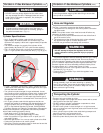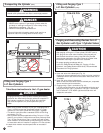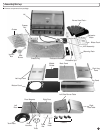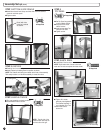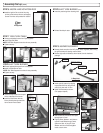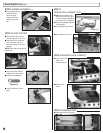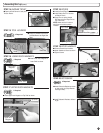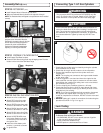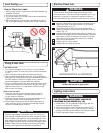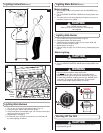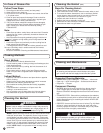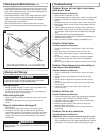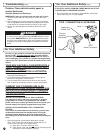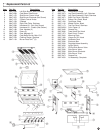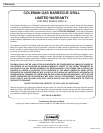Special offers from our partners!

Find Replacement BBQ Parts for 20,308 Models. Repair your BBQ today.

17
Troubleshooting
CAUTION
A collision with the grill, as with any metal object, could cause
injury. Use care when moving a portable gas grill.
Moving the grill:
• Move grill slowly. DO NOT run with or pull the grill behind you;
it could hit you from behind causing injury.
• DO NOT move the grill while it is lit or hot, or with objects on
the cooking surface(s) or side table(s).
After moving the grill:
• Check all gas connections for leaks that could occur from the
movement.
• Check the venturi tubes to be sure they are still over the
orifices.
Steps to follow before storing grill:
• Clean the grill.
• Coat the burner lightly with cooking oil to retard rusting.
• For outdoor use only. If grill is stored indoors, detach and
leave cylinder outdoors. If left outdoors, turn off the fuel supply
to the L.P. cylinder and cover the grill for protection from the
weather. Grill covers may be purchased from a grill dealer or
manufacturer.
WARNING
If the grill is not in use, the gas MUST be turned off at the fuel
supply cylinder.
Moving and Storage
Problem: Burner will not light or has incom-
plete burner flame.
Possible Causes and Solutions:
1. Make sure the 9-volt battery is fresh.
2. Check for spider webs or insect nests in venturi and clean venturi.
3. Lack of fuel. Check to see cylinder valve is open and cylinder
has fuel.
4. Misalignment of venturi on orifices. Position venturi over orifices.
5. Burner ports, orifices, valves or hose have blockage. Clean the
components.
6. If burner lights with match but not Igniter, check ceramic elec-
trode position in gas collector and condition of Igniter wire and
its connections. Perform Igniter test and replace any damaged
parts.
7. Crimped fuel supply hose needs straightened.
8. Regulator failure or damaged hose needs to be replaced by an
authorized service dealer.
9. Make sure hose to cylinder is properly assembled (pg. 12).
Problem: Yellow flame.
Possible Causes and Solutions:
1. Check for spider webs or insect nests in venturi and clean
venturi.
2. New burner may have residual oil which will burn off.
3. Clean off any food residue, grease or seasoning salts on
burner.
4. Air may be in cylinder if cylinder was not properly purged.
Use up remaining gas; the yellow flame may disappear
with use.
5. Venturi may be misaligned and needs to be lined up over orifice.
Problem: Flame blows out on low setting or
has uneven heat distribution.
Possible Causes and Solutions:
1. Check for spider webs or insect nests in venturi and clean
venturi.
2. Cold grill needs to be preheated for 5 minutes on high
setting.
3. Venturi may be misaligned and needs to be lined up over
orifices.
4. Cold and windy weather will require you to move grill away
from the wind.
5. Lack of fuel. Check to see cylinder valve is open and
cylinder has fuel.
Problem: Grill too hot.
Possible Causes and Solutions:
1. Excessive flareups which require the maintenance described
in this book under “IN CASE OF GREASE FIRES.”
2. A damaged orifice or regulator which requires replacement
with factory authorized parts.
3. Buildup of grease inside grill will require cleaning and
emptying grease cup or tray.
4. Choose a lower cooking temperature if using excessively
high settings.
Problem: Fire at any connection.
Possible Causes and Solutions:
IMMEDIATELY shut off cylinder valve and allow grill to cool.
1. Gas is leaking from a faulty connection.Tighten connections
with an adjustable wrench and replace damaged parts. Perform
a leak test on all connections before cooking on grill again.
• COOKING GRIDS: Clean cooking grids with mild soap and hot
water. Remove stubborn residue with a mild cleanser or scrub
brush. Use a brass-bristle brush on porcelain-coated grids. DO
NOT use a commercial oven cleaner.
• PORCELAIN-COATED HEAT TENTS: Wipe off grease residue
using a cleaning pad and a brass-bristle brush to knock off
residue. Use care not to damage porcelain finish. Replace
heat tents to their correct position.
• GRILL INTERIOR: Remove grids and porcelain heat tents.
Scrape side with tools and remove excess grease and cooking
residue.
Orifices
Valves
REPRESENTATIVE ILLUSTRATION
24
Cleaning and Maintenance
(cont.)



